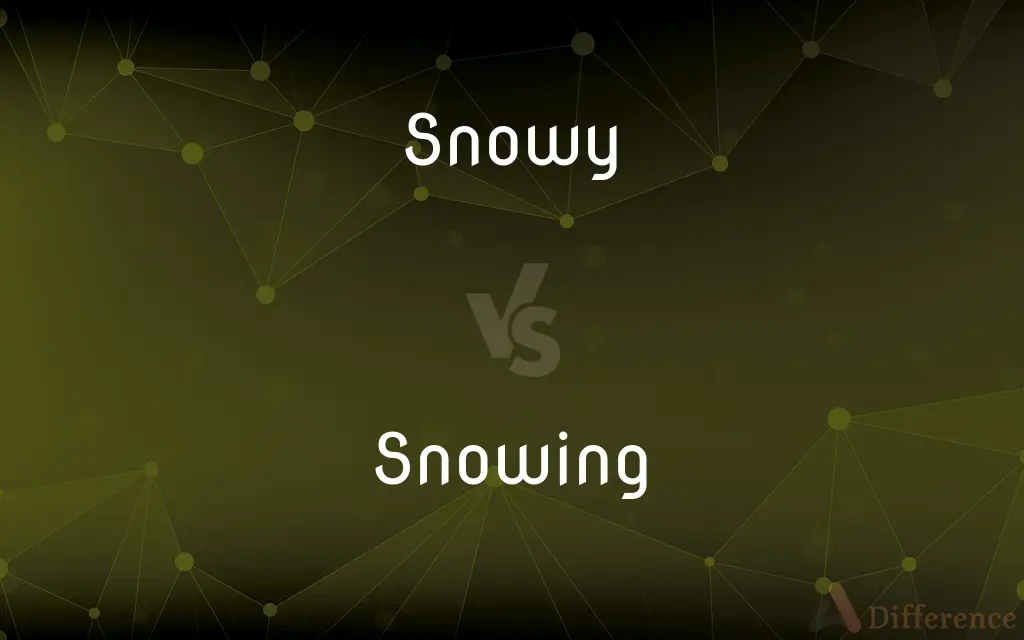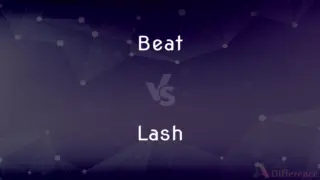Snowy vs. Snowing — What's the Difference?
Edited by Tayyaba Rehman — By Maham Liaqat — Updated on March 21, 2024
"Snowy" describes a landscape covered in snow, indicating a static condition. "Snowing" refers to the act of snow falling, highlighting an ongoing weather event.

Difference Between Snowy and Snowing
Table of Contents
ADVERTISEMENT
Key Differences
"Snowy" is an adjective used to describe a scene or condition where snow covers the ground, buildings, and other surfaces. This term paints a picture of a winter wonderland, suggesting that the snowfall has already occurred and left behind a serene, white blanket. It implies a state of stillness and quiet beauty, often associated with postcard-like landscapes and peaceful, winter scenes. On the other hand, "snowing" is the present participle form of the verb "snow," used to describe the active process of snowflakes falling from the sky. It indicates an ongoing weather event, focusing on the action and movement of snow as it happens. This term is dynamic, bringing to mind the constant change as landscapes are transformed by the accumulating snow.
While "snowy" suggests a passive, unchanging scene, "snowing" implies activity and transformation. Snowy conditions evoke feelings of calm and tranquility, often associated with the aftermath of a snowstorm when everything is blanketed in white. Conversely, snowing creates a sense of anticipation and excitement, as people watch the landscape change in real time, adjusting their plans and activities based on the intensity and duration of the snowfall.
In terms of visual imagery, "snowy" landscapes are static, offering a snapshot in time where the world appears paused and hushed under a layer of snow. The focus is on the visual impact of the snow-covered environment and its aesthetic appeal. In contrast, "snowing" brings a sense of motion and fluidity, as the falling snow adds a dynamic element to the scenery, often captivating onlookers with the gentle dance of snowflakes descending to the ground.
"Snowy" is often used in contexts where the presence of snow is the main subject, highlighting the effects of snow on a landscape, such as in travel brochures or weather reports describing road conditions. "Snowing," however, is used when the action of snow falling is relevant, such as in weather forecasts, discussions about current weather conditions, or in planning activities that depend on real-time weather changes.
Both "snowy" and "snowing" share the common theme of snow but differ significantly in their focus and implications. "Snowy" emphasizes the beauty and stillness of a snow-covered setting, ideal for activities that rely on established snow conditions like skiing on groomed trails. "Snowing" focuses on the ongoing process of snow accumulation, important for understanding immediate weather conditions and their impact on travel, outdoor activities, and overall ambiance.
ADVERTISEMENT
Comparison Chart
Definition
Describes a condition of being covered in snow
Describes the action of snow falling
Type
Adjective
Present participle (verb)
Focus
Static scene or landscape
Dynamic weather event
Implied Action
None - indicates past snowfall
Ongoing - snow is actively falling
Visual Imagery
Still, serene landscapes
Movement, changing landscapes
Common Usage
Describing landscapes, conditions
Weather forecasts, real-time events
Emotional Response
Calmness, tranquility
Anticipation, change
Suitable Activities
Skiing, snow photography
Preparing for snow-related impacts
Compare with Definitions
Snowy
Reflecting a condition after snowfall.
The roads are snowy and require careful driving.
Snowing
Describes a dynamic weather condition.
With it snowing outside, the event was postponed.
Snowy
Used in descriptions of winter settings.
Snowy scenes dominate the artist's winter collection.
Snowing
The act of snow falling from the sky.
It's snowing heavily, affecting visibility.
Snowy
Covered with snow, indicating a serene winter landscape.
The snowy mountains are perfect for skiing.
Snowing
Focuses on real-time weather changes.
The forecast predicts it will be snowing all day.
Snowy
Static, highlighting a snow-covered state.
The snowy fields glistened under the moonlight.
Snowing
Important for weather-related planning.
If it's snowing tomorrow, we'll need to shovel the driveway.
Snowy
Associated with calm and tranquility.
A snowy village at dusk offers a peaceful retreat.
Snowing
Captures the motion and transformation of landscapes.
Watching the snowing scenery is mesmerizing.
Snowy
Abounding in or covered with snow
A snowy day.
Snowing
Frozen precipitation consisting of hexagonally symmetrical ice crystals that form soft, white flakes.
Snowy
Subject to snow
A snowy climate.
Snowing
A falling of snow; a snowstorm.
Snowy
Resembling or suggesting snow, especially in whiteness
Snowy linens.
Snowing
The white specks on a television screen resulting from weak reception.
Snowy
Marked by snow, characterized by snow.
Snowy day
Snowing
(Slang) Cocaine.
Snowy
Covered with snow, snow-covered, besnowed.
Snowy hillside
Snowing
(Slang) Heroin.
Snowy
Snow-white in color, white as snow.
Snowing
To fall as or in snow.
Snowy
(informal) snowy owl
Snowing
To cover, shut off, or close off with snow
We were snowed in.
Snowy
White like snow.
Snowing
(Slang) To overwhelm with insincere talk, especially with flattery.
Snowy
Abounding with snow; covered with snow.
Snowing
Present participle of snow
Snowy
Fig.: Pure; unblemished; unstained; spotless.
There did he lose his snowy innocence.
Snowing
A fall of snow.
Snowy
Marked by the presence of snow;
A white Christmas
The white hills of a northern winter
Snowy
Covered with snow;
Snow-clad hills
Snow-covered roads
A long snowy winter
Snowy
The white color of snow
Common Curiosities
How does "snowing" affect daily activities?
"Snowing" can impact visibility, travel, and outdoor plans, requiring adjustments like wearing appropriate clothing or changing travel routes.
Is "snowy" only used for landscapes?
Mostly, yes. "Snowy" typically describes landscapes, roads, or scenes covered in snow, but it can also apply to objects.
Which term is used to describe the weather condition?
"Snowing" is used to describe the current weather condition of snow falling.
How do meteorologists use these terms?
Meteorologists use "snowing" to describe current precipitation and might use "snowy" to describe expected accumulations or current ground conditions.
Can "snowy" and "snowing" be used interchangeably?
No, because "snowy" describes a condition, and "snowing" describes an action. Their usage depends on the context.
How do "snowy" and "snowing" affect driving conditions?
"Snowing" can reduce visibility and make roads slippery in real-time, while "snowy" conditions may indicate that roads are already covered, possibly compacted, and require cautious driving.
What is the main difference between "snowy" and "snowing"?
"Snowy" describes a static, snow-covered scene, while "snowing" refers to the ongoing action of snow falling.
Are there activities best suited for "snowy" conditions?
Activities like skiing, snowboarding, and snowshoeing are best suited for snowy conditions, which provide the necessary snow cover.
Is one term more positive or negative than the other?
The perception depends on personal preferences and context; "snowy" can be seen as positive for its beauty, and "snowing" can be positive or negative based on its impact on activities.
Why is "snowy" associated with tranquility?
The stillness and uniformity of a snowy landscape evoke feelings of peace and quiet, contrasting with the usual visual and auditory stimuli.
Can "snowing" occur without leading to a "snowy" condition?
Yes, if the snow melts upon contact with the ground, it may be snowing without accumulating into a snowy landscape.
Do these terms have different implications for wildlife?
Yes, "snowy" conditions can affect animal behavior and habitat accessibility, while "snowing" might impact animal movement and feeding patterns.
Share Your Discovery

Previous Comparison
Beat vs. Lash
Next Comparison
Sulfite vs. NitriteAuthor Spotlight
Written by
Maham LiaqatEdited by
Tayyaba RehmanTayyaba Rehman is a distinguished writer, currently serving as a primary contributor to askdifference.com. As a researcher in semantics and etymology, Tayyaba's passion for the complexity of languages and their distinctions has found a perfect home on the platform. Tayyaba delves into the intricacies of language, distinguishing between commonly confused words and phrases, thereby providing clarity for readers worldwide.















































